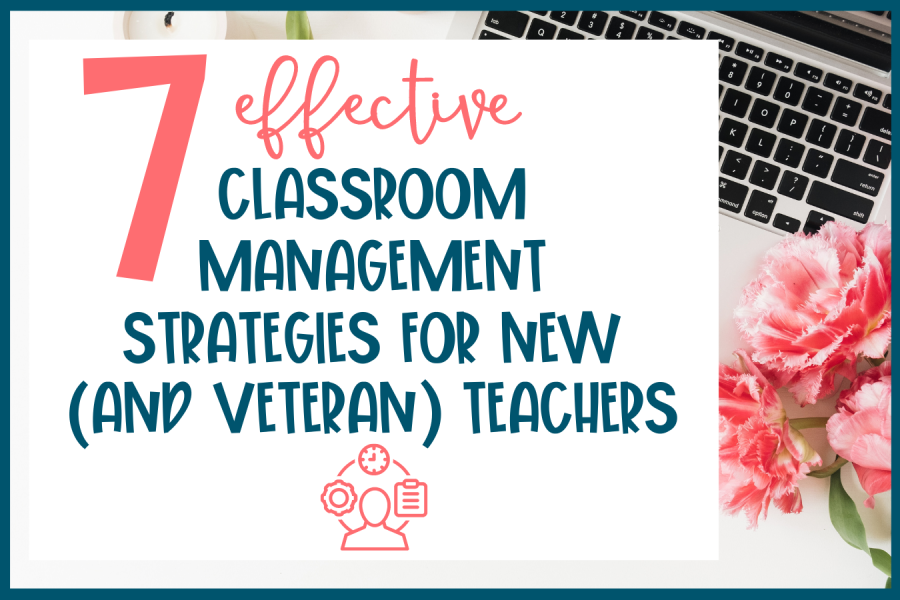Let’s face it—classroom management can feel like trying to wrangle cats sometimes, whether it’s your first year of teaching or you’ve been at it for decades. From students shouting out to racing through the room, the chaos can make you feel like you’re spending all your time managing behavior instead of actually teaching. These seven simple effective classroom management strategies for new teachers (veterans too) can transform your learning environment from wild to wonderful, and they’re so straightforward you could start seeing results by tomorrow!
7 Effective Classroom Management Strategies for New Teachers (and veterans)
Check out these effective classroom management strategies for new teachers and veteran teachers too. Pick the ones where you’re struggling and start trying them out as soon as possible!
Set Clear Expectations
Creating a set of classroom rules and expectations is the first step toward a well-managed classroom. Establish guidelines for classroom procedures, like walking to the carpet in an orderly fashion, how students should sit, and lining up in a rotating number order to prevent those famous “spot-in-line” debates. Make sure these rules are displayed front and center in the classroom, and go over them regularly to keep them fresh. When addressing inappropriate behavior, always point back to these classroom expectations to help guide students toward good behavior.
Create a Consistent Routine
A consistent classroom routine and schedule make a huge difference in setting up a productive learning environment. Use a class schedule that you stick to daily to reduce confusion and limit questions about what’s next. This routine helps foster student engagement, making everyone feel more secure and focused throughout the day. Plus, it saves precious instructional time and keeps the entire class on the right foot.
Use Classroom Visuals and Timers
Visual aids are a teacher’s best friend. Display visuals that show the order of procedures or the supplies needed for an activity to help students understand what to do independently. This not only builds student independence but also means you’re not repeating instructions a hundred times. Supply cards, direction cards, and visual cues are all super helpful.
Visual timers are another great tool, helping students manage their time and understand how long they have left for an activity. They’re perfect for smooth transitions, especially since a lot of times, that’s when disruptive behavior pops up. Use a class slide product with a timer to keep things moving efficiently.
Use a Signal to Get Students’ Attention
To get your students’ attention without losing your voice, try using fun signals. Call-and-response attention getters, a doorbell (you can grab one on Amazon), or flickering the lights are simple things that can really do the trick. These techniques keep students’ focus where it should be and help maintain a positive learning environment.
Implement Warm-Up and Early Finisher Activities
Warm-Ups
Kick off the day with engaging classroom activities like morning bins or morning work. This approach gets students right into learning, even if it’s through play. Use short, fun activities to transition smoothly from one lesson plan to the next. For instance, after morning bins, I start with a “holiday of the day” writing prompt, which gets students writing at their seats for about 10 minutes before we gather on the rug. This sets a positive tone for the rest of the reading/writing block.
Early Finishers
Just like warm-ups get students ready to learn, early finisher activities keep them on track. Instead of letting downtime lead to distractions, have a stash of constructive tasks ready. Keep STEM bins, enrichment activities, or early finisher workbooks on hand so they always have something productive to do, maintaining a positive classroom environment.
Start Classroom Jobs
Introducing classroom jobs is a great way to build a sense of community and give students responsibility. You might think, “I don’t have time for 20+ different jobs or the energy to remember to switch them daily.” But hear me out: classroom jobs can be easy! Instead of changing jobs every day, opt for team jobs that last for a while.
Set up teams of four students each, with roles like team leader, organizer, paper passer, and supply person. These roles give students a sense of purpose and help with student behavior. The team leader encourages active participation, the organizer keeps things tidy, the paper passer distributes materials, and the supply person handles any special materials needed.
For those extra students, add them to teams and give them unique jobs like librarian or tech person. The teamwork and mutual respect that develops are amazing to see.
Incorporate Positive Reinforcement
To encourage good behavior, use tools such as verbal praise, stickers, a treasure box, bucket fillers, and incentive charts. Tailor these rewards to fit individual students, groups, or the entire class. Pick one classroom behavior you want to focus on—transitions, staying on task, or lunchroom behavior—and set up a reward system around it. Once it’s mastered, move on to the next behavior. This process of positive reinforcement helps improve classroom culture and keeps students motivated.
Involve students in picking the incentive chart and reward to get their buy-in. Once they achieve their goal, celebrate with the chosen reward, then pick a new focus area and start again. This cycle not only boosts students’ academic performance but also fosters strong relationships within the classroom.
Hopefully, these tips make the teaching journey smoother and more enjoyable, no matter where you are in your teaching career. With a bit of practice, these classroom management techniques can become a natural part of your teaching style, leading to a thriving, productive learning environment.









